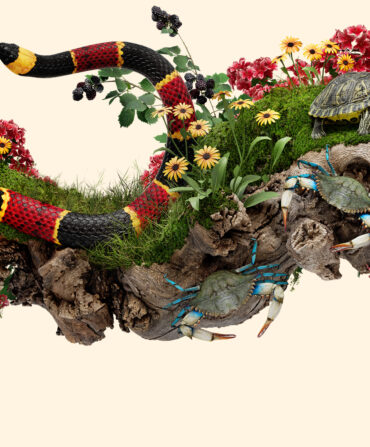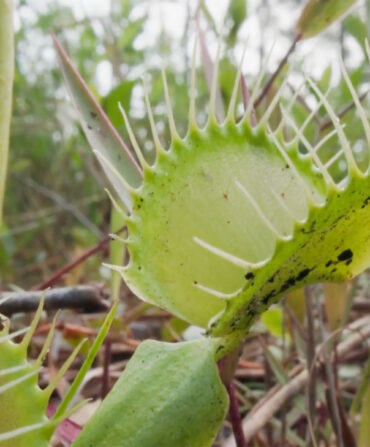It is nearing midnight on an unpaved road bordering the Florida Everglades when Donna Kalil slams on the brakes. Light from her blue F-150 floods the scene along the road, where, within the grass, a sheen of iridescent skin glints, and the sinuous shape and inkblot pattern of a Burmese python leap into focus.
Kalil jumps from the truck, long braid swinging, and moves in on her quarry. At sixty-two years old, Kalil is a full-time, year-round professional python hunter, and the original python huntress: She is the first woman to hold this job, not that gender crosses anyone’s mind out here in the living, breathing wilderness of the Everglades. I am tagging along to witness her in action and to experience what it’s like to catch one of the most devastating invasive species in the world.
The night air, heavy with the promise of rain, reverberates with frog calls. Mindful of where her shadow falls, Kalil positions herself between the python and the endless black reach of swamp beyond it. Then she pounces, angling for a strong grip just behind the head. After a tussle, the Burmese python submits even as it wraps itself, cool and smooth to the touch, around her leg. This brief fight represents the 876th time Kalil has pitted herself against a Burmese python and won—the 876th time she will snap a photo of the snake, lower it into a cloth bag, and load it into her truck. And the 876th time that, later, in private, she will take its life.

Donna Kalil and a captured Burmese python.
Burmese pythons are native to Southeast Asia, where they stalk and swim the marshes, rainforests, and grasslands, preying on just about anything that moves. By the 1970s they had started arriving in Florida, and especially in Miami, as an exotic pet trade boomed. But some pet owners found they didn’t know what to do with a hungry constrictor that was creeping toward twenty feet and two hundred pounds, so they opened cages and back doors and let their companions slither away. Other snakes, perhaps, simply escaped. In 1992, Hurricane Andrew destroyed a breeding center for pet pythons near the Everglades, loosing hundreds more. In a tropical landscape that so nicely echoed their homelands, the reptiles began to do what they do best—hunt.
In general, snakes are eating machines. Evolution sculpted them for the task, outfitting them with an almost surgical capacity for killing: solid-muscle bodies with organs packed sleekly inside, elastic jaws to fit large victims, and various methods of neat execution ranging from muscle-freezing venom to constriction. Of their four thousand–plus relatives, Burmese pythons number among the five largest snakes in the world. And though they don’t belong there, Florida, with its year-round warmth and plentiful prey base, suits the giant reptiles. Had they been released anywhere with reliable cold snaps, they wouldn’t have stuck. But down at the sweltering tip of our continent, so welcoming to invasives like Tegu lizards, feral hogs, and Cuban tree frogs, the pythons thrived. And by the time the U.S. Fish and Wildlife Service banned their import to the United States in 2012, they already had Florida in a choke hold.
Because of the snakes’ secretive nature and the difficult terrain they inhabit, biologists haven’t yet agreed on a hard estimate of how many pythons roam the Everglades, though guesses reach into the hundreds of thousands. Their abundance is best measured by their impact: In Everglades National Park, more than 90 percent of fur-bearing animals have disappeared since the early 2000s, helpless against a predator for which they have no defense.
So it goes with all invasive species. By suddenly introducing a playing piece from a completely different game, humans have changed the rules. Natural selection requires generations upon generations to work the magic of evolution; the Everglades and its web of life as we know it have existed for five thousand years. In the comparative blink of an eye, that intricate system has been upended. And so in a place where they don’t belong, the only real predators of a Burmese python are the ones who brought them here in the first place.
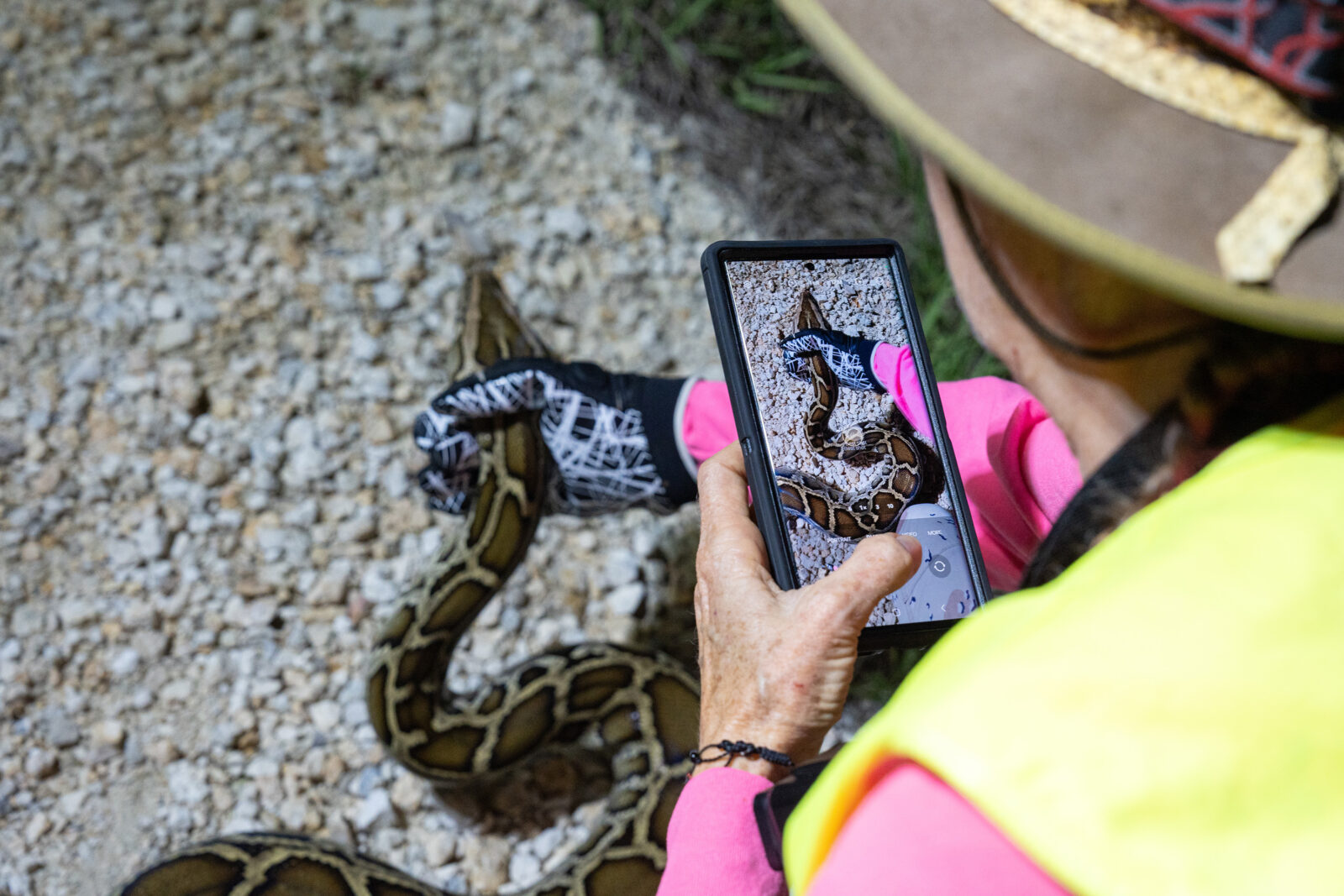
Kalil documents each python she removes, as required by her job.
In 2017, biologist Mike Kirkland was tasked with putting together a three-month pilot program for python bounty hunters. At the time, he was combating invasive plants with the Florida Water Management District—the lead agency on most Everglades restoration projects—which oversees a sixteen-county area running from the upper Kissimmee chain of lakes down to Florida Bay. By then, the python problem was rampant. Invasive species are like an escaped cart down a hill: The longer it takes to get a hold on them, the faster the issue flies out of control.
And so he found himself with just six weeks to assemble his team. “We started by choosing twenty-five spirited individuals from the public,” Kirkland recalls. He remembers reading Kalil’s résumé: “She had martial arts experience, she had participated in python challenges, she was a military brat, and she’d been catching snakes all her life. Even on paper, she was interesting.”
The pilot program aimed to simply explore the possibility that bounty hunters might prove a viable management strategy. No one expected the small team, on which Kalil was the only woman, to catch a record-setting 163 snakes in three months. The agency extended the program, then extended it again. Soon it achieved permanence, with fifty contractors employed under the Florida Water Management District and fifty more under the Florida Fish and Wildlife Conservation Commission. In total, a hundred full-time python elimination specialists came on board, including about a dozen women.
In person, Kalil is wiry, soft-spoken, and easygoing, but a clear vein of no-frills toughness runs through her. “I’ve been chasing after snakes my whole life,” she says. She remembers a roving childhood of hunting, fishing, and dashing after her brothers across wild landscapes, all while learning a deep respect for the animals they harvested. The itinerant family eventually settled in Miami, and Kalil stayed, later working in real estate, marrying, and having children. In 2015, after hearing about the havoc the snakes were wreaking on the Everglades—and noticing firsthand the lack of swamp rabbits, raccoons, and possums in South Florida—she volunteered to put her outdoor skills to use. She remembers her first catch: a twelve-foot python on Loop Road.
As the first (and for some time, only) woman in the program, Kalil quickly proved herself up to the job—one requiring patience, a love of nature, a keen eye, and fearlessness. This fall, she took first prize in the professional category of the 2024 Florida Python Challenge for removing nineteen Burmese pythons in ten days. “You can take male or female out of the equation completely,” Kirkland says. “Donna is one of our very best contractors, period.” Once she spots a python, she pursues it with cool focus and an iron will. She will enter water and traverse swamp. She has been bitten more times than she can count; though not venomous, pythons possess rows of curved, needle-sharp teeth. The constrictors have wrapped around pretty much every part of her; once, one wound itself around her neck. “It’s a dynamic situation out here,” she says. “You’ve got to be on your toes, and it’s best to bring a buddy.”
In all of Kalil’s time hunting, only five pythons have escaped once sighted, and they haunt her—especially one eighteen-foot-plus monster that threw her off “like a rag doll,” she says, after she straddled it in the water. “I did everything I could do, and that one was just tougher than me. I remember watching it take off into the night, thinking it was an awe-inspiring animal.” The potential for removing a python that big drives her every time she goes out, both for the danger it poses to the environment and the challenge it poses to her: “At any moment, you could have a big adventure and a real fight on your hands.”
With her easy warmth and Jane Goodall–like persona, she has raised awareness of the issue in countless media outlets and brought scores of volunteers hunting with her. “She really is an inspiration to everyone,” Kirkland says, “and especially to young women out there.” One such young woman, Tanya Toutant, heard of Kalil through a friend while working at a T-shirt printing shop. “I couldn’t believe that I had lived in the Fort Lauderdale area all my life without knowing about the python problem,” she says. “And then I hear about this woman who is out there kicking butt, doing crazy things women don’t usually do.” She reached out to Kalil on Facebook, and before long, she found herself volunteering as a spotter. Two years later, Toutant still joins Kalil in the field multiple times a week. “We have the same passion for nature, and like her, I just want to make a positive impact on the world.”
In the summer months, the python hunters, often joined by volunteers, go out at night, when the temperature is right for the snakes to move. In the winter they switch to daytime, when the reptiles bask in the sun. On a humid May night I meet Kalil and her brother, Dave, also an invasive species specialist, in the parking lot of Miccosukee Casino on the edge of the Everglades. They are impossible to miss: A spotting platform that she designed herself—and that many of her counterparts have since replicated—towers from the truck bed. Kalil wears light camouflage pants, a pink shirt, and a python-skin hat.
On the drive to our first site, she gives me a crash course in python spotting: “Use a floodlight to scan the ground near the truck, and look for an iridescence and a pattern. Shine your light a little ahead of you to help with the vertigo. Shout ‘Python!’ if you think you see something, even if you’re not positive—it’s better to be wrong than to miss one. Have your legs under you because when I brake, I’m going to brake hard.”
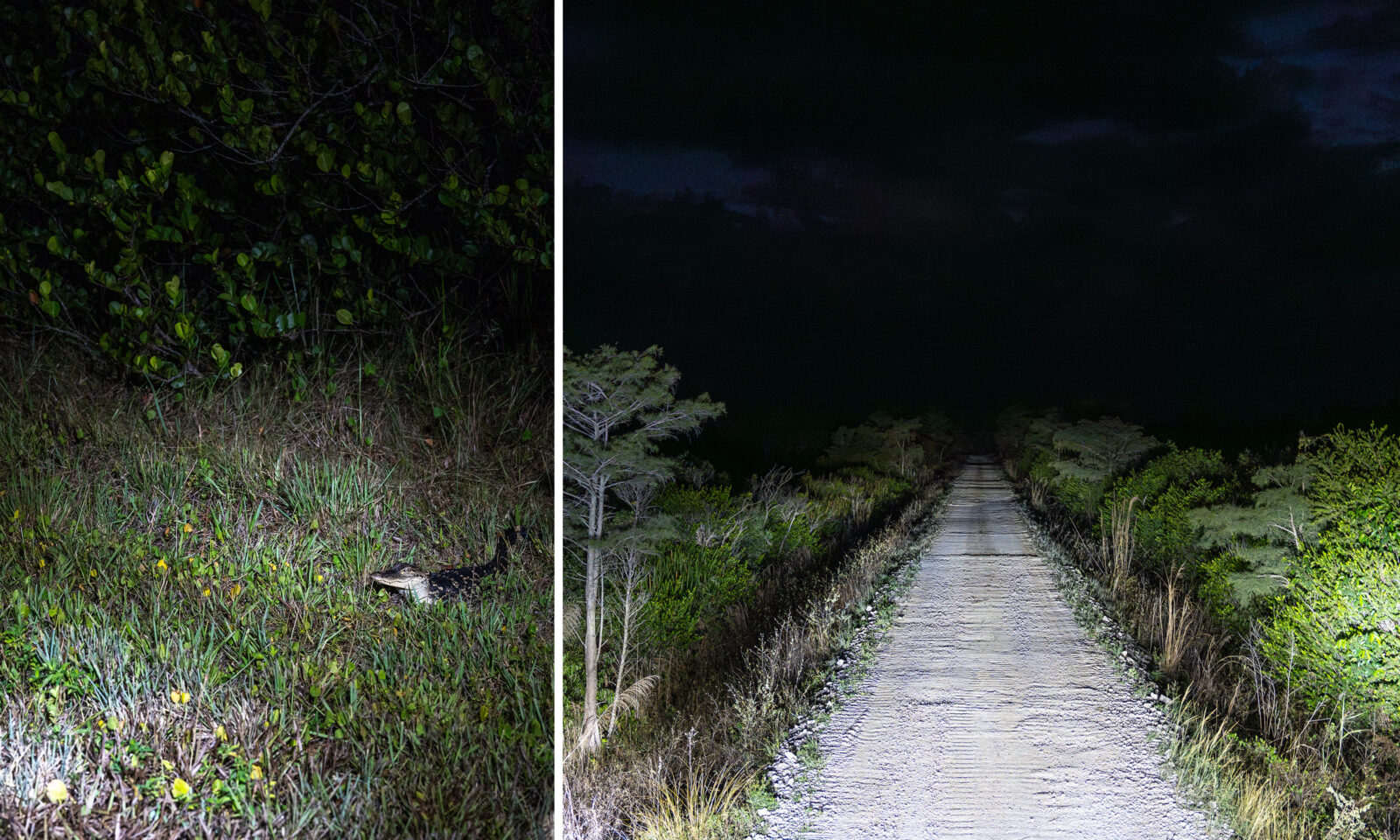
A small alligator caught in the spotlight; a levee road through the Everglades.
The lack of a concrete estimate notwithstanding, there are, by all accounts, a lot of pythons on the landscape. That does not mean they are easy to find. For nearly two hours, we scan the roadsides of a levee, thick with saw palmettos and trees whose leaves litter the ground. Soon, every stick begins to look like a snake. My eyes start to ache from straining to pull out the form of a python among all the passing shapes and colors. The moment you stop paying attention is the moment you miss one is a belief Kalil and her spotters live by, and it’s true—the first python we see is crossing the road, and I barely glimpse it in time for us not to run it over. After the on-your-toes tension of scanning and waiting, there’s a sudden shot of adrenaline as we all pile out of the truck.
This python is little more than a baby, just five or so feet long. Kalil scoops it up easily, though as she holds it out to show me, a sharp tooth nicks her finger, drawing blood. “Normally,” she says, “we don’t sit around admiring the catch—we move on quick, both for the python’s sake and because lots of times there’s a small window of time where they’re moving around.” But for a first-timer, there is much to admire. The python’s head widens and tapers elegantly, and its eyes are round black beads. Its skin is beautiful—a kaleidoscope of blacks, browns, and golds that easily dissolves into the grassy expanses of the Everglades. The rest of the night, long after we move on, I think of the young snake in the back of the truck, waiting to pay for a crime it did not commit.
“Euthanization is the dark side of our jobs,” Kalil’s brother tells me. Florida’s full-time python hunters are lovers of wildlife down to the last one. They don’t do it for the money, because they don’t make much more than minimum wage, and they don’t do it for the thrill, because Kirkland simply won’t hire anyone looking at the job as a chance to kill. “Certainly those with that mentality exist,” he says. “But on my team, you will find no bloodlust for these poor animals.” Snakes are incredibly resilient creatures. Even with grievous injuries—including decapitation—they can retain consciousness and feel pain.
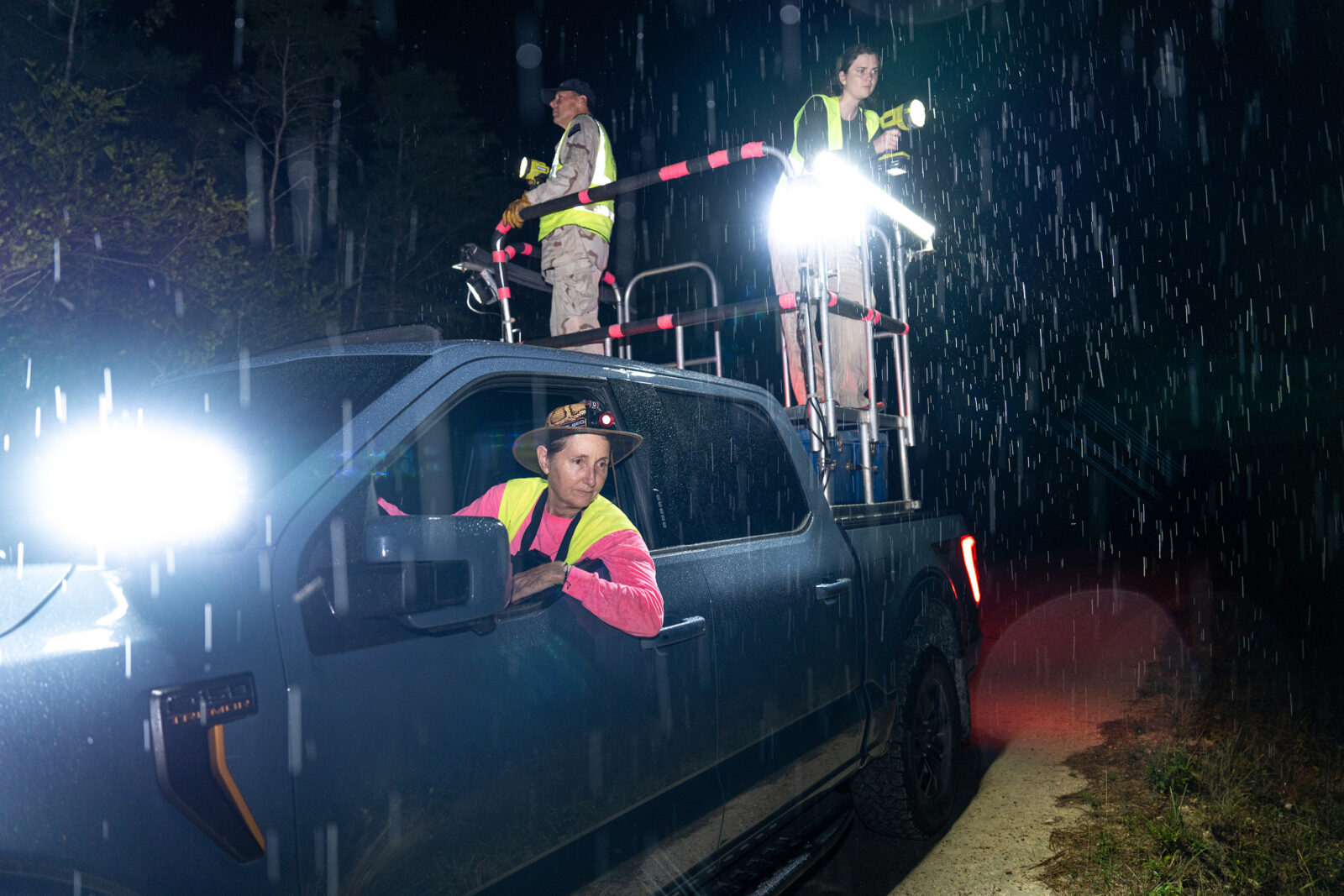
Kalil’s brother and the writer spotting from the platform, with Kalil behind the wheel.
The elimination program has strict rules to ensure no python suffers: First, hunters use an air gun or a captive bolt to the head to render the subject unconscious. Then they make sure it will never wake again by pithing—driving a metal tool like a screwdriver, spike, or pick into the cranial cavity and manually destroying the brain. Kalil does not like to talk about this part of her job. It is something she does alone, in the privacy of her garage. “Before I do it, I tell each python that I’m sorry for what I have to do,” she says, and falls silent.
Kirkland says the day he becomes desensitized to the killing will be the day he quits. “I have to remind myself of the big picture for each and every one of the almost nine thousand pythons this program has removed,” he says. “It’s a heavy burden, to have this much blood on your hands.”
Instead, the hunters focus on all the native animals they are protecting by removing the pythons from the wild. This bigger picture can be distilled into the body of each snake, which can eat the contents of a small zoo in its lifetime.
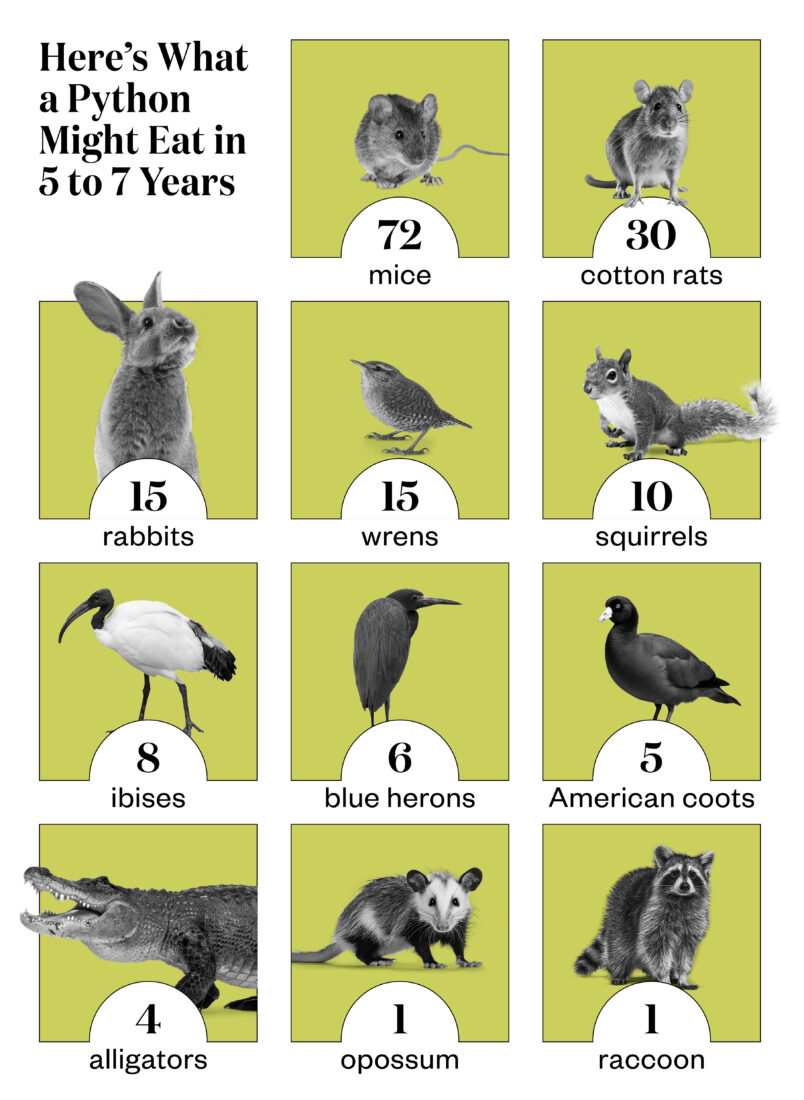
Illustration: SIDNEY THOMASON; PHOTOS: ADOBE IMAGES; SOURCE: SOUTH FLORIDA WATER MANAGEMENT DISTRICT
Now imagine thousands upon thousands of pythons, their slow digestion transforming each corpse into python muscle and fat. Unaided, Florida’s native wildlife doesn’t stand a chance. “That’s what I think about with every python I catch,” Kalil says. “What it ate to get this big, and the lives I’m saving by removing it.”
Biologists are taking a multipronged approach to the issue. They have experimented with enlisting dogs to sniff out both pythons and nests—a technique that has proved difficult in such hot weather and inhospitable landscapes. Ongoing projects use telemetry to track pythons to find “associate snakes.” Researchers use drones, go out in airboats, or even take to helicopters to locate their subjects in the interiors of the Everglades.
Always, agencies and individuals are looking for the next best methods. “But for now, the python contractor program is the most successful management effort in the history of the issue,” Kirkland says. “We’re capturing more and more—something that is indicative of the python population out there and indicative of us getting better at what we do.”
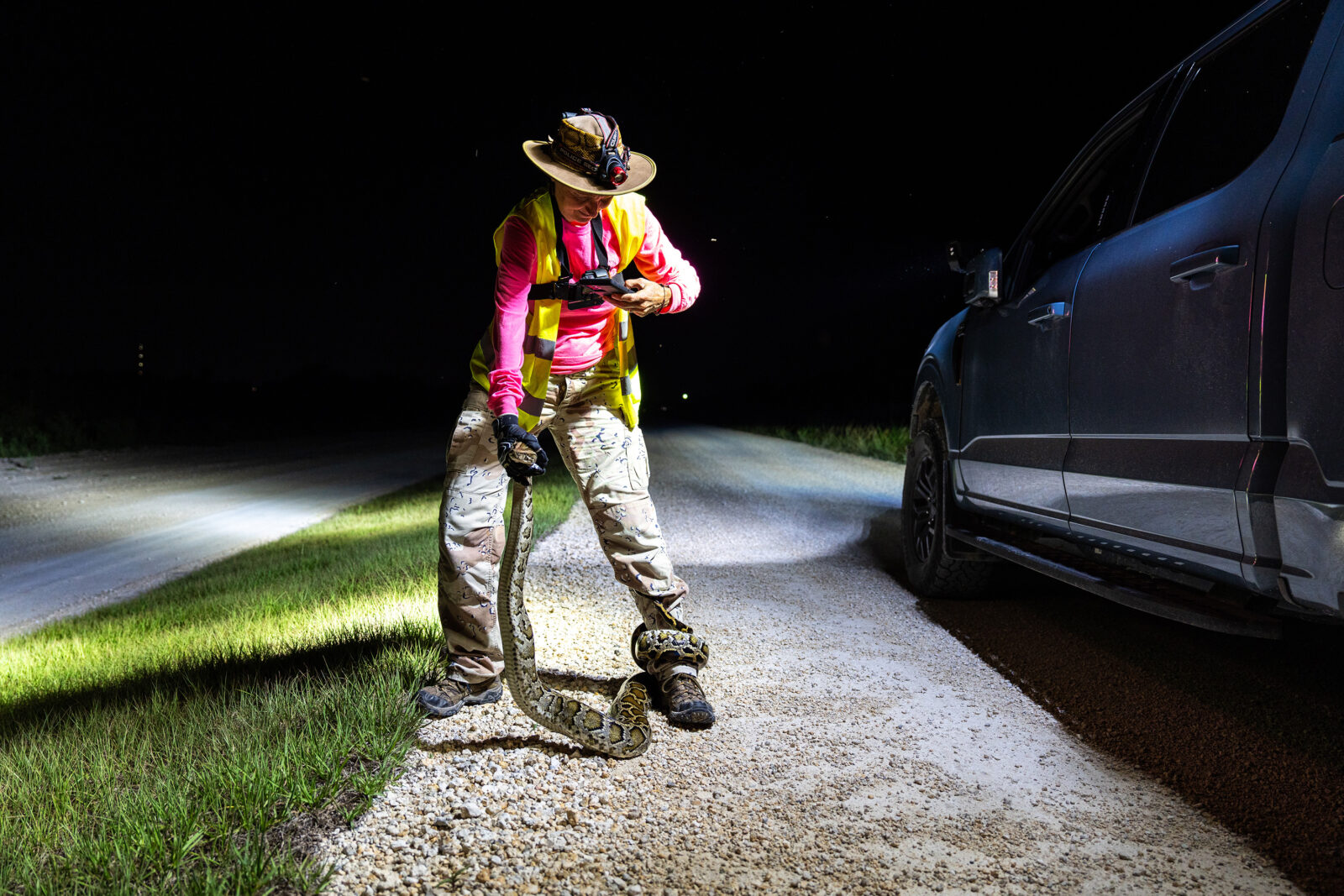
Kalil photographs a catch.
Though they sometimes try to penetrate the Everglades on foot or by boat, most contractors find that the best way to catch pythons is cruising by vehicle along levee access roads. “The edges of wildlife habitats are important movement corridors for predator and prey alike,” Kirkland explains. “Pythons are semiaquatic animals, but they have to come to these upland areas where the levees are to hunt and reproduce.”
So far, the data suggests that native wildlife is responding in the areas the contractors patrol; though they might not be surging back, mammals and birds are finding the toehold they need to survive. While no one believes the pythons will ever be fully eradicated, Kirkland is hopeful that in twenty years, native wildlife might have regained more than a toehold, and the issue might lessen into something close to manageable.
On my second night hunting with Kalil, we cruise for hours with no luck. From my perch on the platform, I let my spotlight rove beyond the roadside until its light is swallowed by a vast and dark expanse of grass. Unbidden, I feel a wave of frustration. We are patrolling the periphery of a vast ecosystem, relying on chance encounters. How many pythons do we miss by a stroke of bad timing? How many lie just beyond our vision? How many within our vision do we just fail to see? And how many hide within the Everglades, really, for the hunters to catch as many as they do, night after night?
Kalil is not immune to thoughts like these. Some nights she goes home empty-handed—on average, a contractor searches for ten hours to find a single python. But action dispels hopelessness. Her words, in response to a haltingly voiced question, float up through the truck’s open sunroof to the platform where I stand with my light illuminating the endless sea of grass. “I just don’t let myself think that way, because we can’t just give up. We can’t do nothing.”
That philosophy is pivotal to her identity. She remembers wondering, when her first child was born, how she could have brought such a beautiful baby into a world so lacking in environmental stewardship. Her yard is planted full of natives, inviting pollinators and birds. During my visit, she has plans to rise early in the morning—even after clocking out well past 2:00 a.m.—to attend a class on coral restoration so she can help with reef recovery efforts in the Keys. And as long as she’s able, she says, she will hunt pythons.

Kalil and the writer lower a captured python into a white cloth bag; it will later be euthanized.
Over the course of the two nights I spend hunting with Kalil, native wildlife reveals itself at every turn. On one levee road, we stop to move a water snake out of our path. Kalil approaches the harmless reptile with the same care she uses to corner a python, crouches next to it, and gently extends her finger to tickle its scaly chin, causing it to amble along to safety. We see a yellow-bellied slider in the act of laying eggs. We pause to admire a musk turtle and watch a young alligator watching us from the shallow water. We cross paths with a brilliant orange corn snake, which Kalil lets wind its way up her arm before carefully sending it on its way. The eyes of nighthawks flash in our headlights.
Somewhere in the night air along those roads—in the pulsing chorus of insects and tree frogs, in the crunching of tires over dirt, in the patter of rain and the shining of the moon—I think I understand why Kalil is here, and how she finds peace amid the inherent violence of her job. I understand why she will jump on a seventeen-foot python and set aside her love of snakes to drive a pithing knife into its brain. I understand how life in the Everglades is both delicate and resilient, and how poignant it is to mourn the power we have to destroy, and to wield the power we have to heal.
As a whippoorwill sings overhead, Kalil catches our third and final python—a female, possibly carrying eggs. The snake moves gingerly, perhaps to protect the life within her, and puts up no fight as Kalil and I quietly lower her into the white cloth bag.


